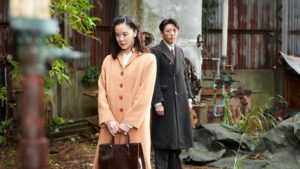STUDIO: Kino Lorber | DIRECTOR: Kiyoshi Kurosawa | CAST: Yû Aoi, Issey Takahashi, Masahiro Higashide, Ryôta Bandô, Yuri Tsunematsu, Minosuke
RELEASE DATE: 11/16/21 | PRICE: DVD $13.29, Blu-ray $19.69
BONUSES: Featurette “Making of Wife of a Spy”
SPECS: NR | 116 mins | Foreign language drama | 1.85:1 | 5.1 surround |
Kiyoshi Kurosawa has had a most interesting career arc. A supremely talented filmmaker (and no relation to Akira), he emerged out of the world of low-budget genre movies to craft a number of memorable bigger-budgeted crime pictures and supernatural films (Cure, Charisma, Pulse). Although he is perfectly capable of continuing to make thoroughly original genre pics, which he has done through the last two decades, he also has established a solid career in melodrama, making films with an abundance of genuine emotion (Tokyo Sonata, Penance, Daguerrotype) that have attracted mainstream arthouse audiences.
Wife of a Spy, which was produced as a Japanese telefilm, is just such a melodrama, qualifying as both a wartime thriller and a pointed character study. Kurosawa and his fellow scripters (Ryûsuke Hamaguchi, who directed and wrote the current arthouse hit Drive My Car, and Tadashi Nohara) have fashioned a beautiful blend of romance, debates over morality and patriotism, and betrayal.
Set in 1940, the plot revolves around a businessman (Issey Takahashi) who makes business trips, during which he gathers location images for his own amateur thriller films. Upon his return from one such trip (to Manchuria), he conceals a number of secrets from his doting wife (Yû Aoi). She is brought in for interrogation by a former schoolmate (Masahiro Higashide) who now is head of the local military, and is told her husband is suspected of betraying Japan. When she confronts him about it, he notes that he is not a spy — he does what he does of his own free will, and not because he is part of any network of spies. From that point on, the plot goes in thrilling and poignant directions, none of which will be revealed here.
Wife is made more complex by the evidence the husband hopes to show U.S. policy makers (in order to force them to join the war against Japan), which reveals specifics about the torture and biological warfare carried out against the Chinese by the Japanese. Real images of these activities are included in the film, lending a more concrete aspect to the fictional plotline.
 Throughout the film, which won the Silver Lion at Venice, Kurosawa harkens back to the “women’s pictures” of the Forties and Fifties made in both Japan and the U.S., while also including Hitchcockian elements in sequences depicting deception and betrayal. He reinforces this with different visual techniques (tight closeups; overly bright lighting from windows in indoors sequences, which adds a claustrophobic element to the proceedings). Add to that dead silence during key moments of suspense, which is then replaced by ominous musical overtones courtesy of composer Ryosuke Nagaoka.
Throughout the film, which won the Silver Lion at Venice, Kurosawa harkens back to the “women’s pictures” of the Forties and Fifties made in both Japan and the U.S., while also including Hitchcockian elements in sequences depicting deception and betrayal. He reinforces this with different visual techniques (tight closeups; overly bright lighting from windows in indoors sequences, which adds a claustrophobic element to the proceedings). Add to that dead silence during key moments of suspense, which is then replaced by ominous musical overtones courtesy of composer Ryosuke Nagaoka.
The two lead performances are beautifully nuanced. At different points our perception of these characters changes, with Aoi and Takahashi admirably succeeding in making both characters sympathetic and oddly suspicious. Aoi has the bigger of the two roles, and her performance ranges from scenes in which she appears cold-hearted to other moments in which she is a wild-eyed innocent.
The only extra in this package is a Japanese making-of video that covers different aspects of the film’s creation: pre-production, rehearsals, and shooting. Takahashi praises the picture, saying, “I don’t think there are many movies that the audience can draw the thread together on their own. It’s rare to see a work that doesn’t have any guides.” (Referring here to the conclusion, which insinuates a particular action by a lead character that is implied by a briefly seen image.)
Most interesting is seeing Kurosawa’s infinite attention to detail — extending to having a crew member shake branches in a tree so a particular “breeze” effect will be seen in one shot. (Can’t get any lower-fi than that.) One crew member discusses how four cameras are commonly used on Japanese TV productions, but Kurosawa most often used just one or two, because he was going to assemble the results in the editing.
Kurosawa’s unusual approach included shooting a concluding scene from the second half of the film before the first half. He attributes this to “scheduling” but then is seen saying he prefers this method, since it creates a different sort of energy among the performers and crew. He admits it is “kind of extreme” but that, with concluding sequences completed before the middle of the production, “both the staff and the actors get settled quickly.”
The featurette’s most delightful moments occur when we see the official rituals that begin and ended most days of shooting. To begin a shoot, the players would be introduced to the crew, who would then give them a round of applause; at the end of a given performer’s shoot, they (whether female or male, lead or supporting role) would be presented with a bouquet of flowers by Kurosawa himself and yet another round of applause. One can’t imagine that occurs on the set of too many American telefilms.
|
Buy or Rent Wife of a Spy
|
|---|
Leave a Reply